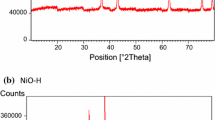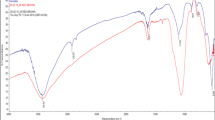Abstract
This study was conducted to evaluate the efficiency of low-cost adsorbents including bentonite, kaolinite and zeolite saturated with calcium and potassium, potato and wheat residues, and three metal oxide nanoparticles functionalized with an acidic extract of potato residues in improving the quality of sodic waters. The optimization of factors such as pH, contact time, and adsorbent dosage was investigated using a solution containing sodium, calcium, magnesium, and potassium. The optimal pH and contact time were 7.0 and 24 h, respectively. The optimal dosage for using functionalized nanoparticles was 0.1 g and for using other adsorbents was 1.0 g. The sodium exchange isotherms were conducted in binary sodium–calcium and sodium–potassium and quaternary sodium–calcium–magnesium–potassium systems. Zeolite saturated with potassium was the most effective adsorbent in removing sodium from aqueous solutions with an average removal efficiency of 69.2 and 66.5 % in binary and quaternary systems, respectively. Freundlich and Langmuir equations fitted well to experimental data in both binary and quaternary systems. Cation selectivity coefficients calculated based on the Gaines–Thomas convention varied with changing pH and adsorbent dosage. Graphical and statistical evaluations confirmed that the mechanistic cation exchange model using average Gaines–Thomas selectivity coefficients in geochemical PHREEQC program was able to successfully simulate the sodium exchange on different adsorbents in both systems. The Gaines–Thomas selectivity coefficient values greater than unity and as a consequence, the negative values of the Gibbs free energy change of adsorption indicated that sodium exchange reactions in the presence of different adsorbents used is this study were exergonic and spontaneous.














Similar content being viewed by others
References
Bethke CM, Brady PV (2000) How the K d approach undermines ground water cleanup. Ground Water 38:435–443
Bohn HL, Mcneal BL, O’Connor GA (2001) Soil chemistry, 2nd edn. Wiley, New York, p 320
Dang VBH, Doan HD, Dang-Vu T, Lohi A (2009) Equilibrium and kinetics of biosorption of cadmium(II) and copper(II) ions by wheat straw. Bioresour Technol 100:211–219
Dzombak DA, Morel F (1990) Surface complexation modeling: hydrous ferric oxide. Wiley, New York, p 416
Eccles H, Hunt S (1986) Immobilization of ions by biosorption. Ellis Horwood Limited, Chichester, p 266
Farooq U, Khan MA, Athar M (2007) Triticum aestivum: a novel biosorbent for lead (II) ions. Agrochimica 51:309–318
Farooq U, Kozinski JA, Khan MA, Athar M (2010) Biosorption of heavy metal ions using wheat based biosorbents—a review of the recent literature. Bioresour Technol 101:5043–5053
Feizi M, Jalali M (2016) Sorption of aquatic phosphorus onto native and chemically-modified plant residues: modeling the isotherm and kinetics of sorption process. Desalination Water Treat 57(7):3085–3097
Freundlich HMF (1906) Over the adsorption in solution. J Phys Chem 57:385–471
Gaines GL, Thomas HC (1953) Adsorption studies on clay minerals, II, a formulation of the thermodynamics of exchange adsorption. J Chem Phys 21:714–718
Gascó G, Méndez A (2005) Sorption of Ca2+, Mg2+, Na+ and K+ by clay minerals. Desalination 182:333–338
Gupta VK, Ali I (2001) Removal of DDD and DDE from wastewater using bagasse fly ash, a sugar industry waste. Water Res 35(1):33–40
Gupta VK, Nayak A (2012) Cadmium removal and recovery from aqueous solutions by novel adsorbents prepared from orange peel and Fe2O3 nanoparticles. Chem Eng J 180:81–90
Gupta VK, Agarwal S, Saleh TA (2011a) Synthesis and characterization of alumina-coated carbon nanotubes and their application for lead removal. J Hazard Mater 185:17–23
Gupta VK, Jain R, Saleh TA, Nayak A, Malathi S, Agarwal S (2011b) Equilibrium and thermodynamic studies on the removal and recovery of Safranine-T dye from industrial effluents. Sep Sci Technol 46(5):839–846
Gupta VK, Ali I, Saleh TA, Nayak A, Agarwal S (2012) Chemical treatment technologies for wastewater recycling: an overview. RSC Adv 2:6380–6388
Gupta VK, Nayak A, Agarwal S (2015) Bioadsorbents for remediation of heavy metals: current status and their future prospects. Environ Eng Res 20(1):001–018
Hall KR, Eagleton LC, Acrivos A, Vermeulen T (1966) Pore- and solid-diffusion kinetics in fixed-bed adsorption under constant-pattern conditions. Ind Eng Chem Fund 5:212–223
Ho YS (1995) Adsorption of heavy metals from waste streams by peat. PhD Thesis, University of Birmingham, Birmingham
Ho YS, McKay G (1998) A comparison of chemisorption kinetic models applied to pollutant removal on various sorbents. Process Saf Environ 76(4):332–340
Hutcheon AT (1966) Thermodynamics of cation exchange on clay: Ca–K montmorillonite. J Soil Sci 17:339–355
Jalali M, Rajabi F, Ranjbar F (2016) The removal of boron from aqueous solutions using natural and chemically modified sorbents. Desalination Water Treat 57(18):8278–8288
Jardine PM, Sparks DL (1984) Potassium–calcium exchange in a multireactive soil system: II. Thermodynamics. Soil Sci Soc Am J 48:45–50
Kim JW, Sohn MH, Kim DS, Sohn SM, Kwon YS (2001) Production of granular activated carbon from waste walnut shell and its adsorption characteristics of Cu2+ ion. J Hazard Mater 85(3):301–315
Koretsky C (2000) The significance of surface complexation reactions in hyrologic systems: a geochemist’s perspective. J Hydrol 230:127–171
Langmuir I (1916) The constitution and fundamental properties of solids and liquids. J Am Chem Soc 38(11):2221–2295
Leppert D (1990) Heavy metal sorption with clinoptilolite zeolite alternatives for treating contaminated soil and water. Min Eng 42:604–608
Lin J, Zhan Y, Zhu Z (2011) Evaluation of sediment capping with active barrier systems (ABS) using calcite/zeolite mixtures to simultaneously manage phosphorus and ammonium release. Sci Total Environ 409:638–646
Mahdavi S, Jalali M, Afkhami A (2012) Removal of heavy metals from aqueous solutions using Fe3O4, ZnO, and CuO nanoparticles. J Nanopart Res 14:846–863
Malcom RL, Kennedy VC (1969) Rate of cation exchange on clay minerals as determined by specific ion electrode techniques. Soil Sci Soc Am Proc 33:247–253
Merrikhpour H, Jalali M (2013) Comparative and competitive adsorption of cadmium, copper, nickel, and lead ions by Iranian natural zeolite. Clean Technol Environ Policy 15(2):303–316
Moharami S, Jalali M (2013) Removal of phosphorus from aqueous solution by Iranian natural adsorbents. Chem Eng J 223:328–339
Motsi T, Rowson NA, Simmons MJH (2009) Adsorption of heavy metals from acid mine drainage by natural zeolite. Int J Miner Process 92:42–48
Murphy V, Tofail SAM, Hughes H, McLoughlin P (2009) A novel study of hexavalent chromium detoxification by selected seaweed species using SEMEDX and XPS analysis. Chem Eng J 148:425–433
Parkhurst DL, Appelo CAJ (1999) User’s guide to PHREEQC (version 2): a computer program for speciation, batch-reaction, one-dimensional transport, and inverse geochemical calculations. United States Geological Survey, Water Resources Investigations Report 99-4259, Washington, DC, p 326
Rafatullah M, Sulaiman O, Hashim R, Ahmad A (2009) Adsorption of copper (II), chromium (III), nickel (II) and lead (II) ions from aqueous solutions by Meranti sawdust. J Hazard Mater 170:969–977
Rivera-Utrilla J, Bautista-Toledo I, Ferro-García MA, Moreno-Castilla M (2001) Activated carbon surface modifications by adsorption of bacteria and their effect on aqueous lead adsorption. J Chem Technol Biotechnol 76:1209–1215
Rowell DL (1994) Soil science: methods and applications. Longman Group, Harlow, p 345
Saeed A, Akhtar MW, Iqbal M (2005) Removal and recovery of heavy metals from aqueous solution using papaya wood as a new biosorbent. Sep Purif Technol 45:25–31
Saleh TA (2015) Isotherm, kinetic, and thermodynamic studies on Hg(II) adsorption from aqueous solution by silica-multiwall carbon nanotubes. Environ Sci Pollut Res 22(21):16721–16731
Saleh TA (2016) Nanocomposite of carbon nanotubes/silica nanoparticles and their use for adsorption of Pb(II): from surface properties to sorption mechanism. Desalination Water Treat 57(23):10730–10744
Saleh TA, Gupta VK (2014) Processing methods, characteristics and adsorption behavior of tires derived carbons: a review. Adv Colloid Interface Sci 211:93–101
Shainberg I, Oster JD, Wood JD (1980) Sodium/calcium exchange in montmorillonite and illite suspensions. Soil Sci Soc Am J 44:960–964
Tang L, Sparks DL (1993) Cation-exchange kinetics on montmorillonite using pressure-jump relaxation. Soil Sci Soc Am J 57:42–46
Tertre E, Prêt D, Ferrage E (2011) Influence of the ionic strength and solid/solution ratio on Ca(II)-for-Na+ exchange on montmorillonite. Part 1: chemical measurements, thermodynamic modeling and potential implications for trace elements geochemistry. J Colloid Interface Sci 353:248–256
Tertre E, Hubert F, Bruzac S, Pacreau M, Ferrage E, Prêt D (2013) Ion-exchange reactions on clay minerals coupled with advection/dispersion processes. Application to Na+/Ca2+ exchange on vermiculite: reactive-transport modeling, batch and stirred flow-through reactor experiments. Geochim Cosmochim Acta 112:1–19
Udo EJ (1978) Thermodynamics of potassium–calcium and magnesium–calcium exchange reactions on a kaolinitic soil clay. Soil Sci Soc Am J 42:556–560
Acknowledgments
We are thankful to Department of Soil Science, College of Agriculture, Bu-Ali Sina University which this research was conducted there.
Author information
Authors and Affiliations
Corresponding author
Rights and permissions
About this article
Cite this article
Ranjbar, F., Jalali, M. Empirical and mechanistic evaluation of sodium exchange isotherms on natural mineral and organic adsorbents and organically functionalized nanoparticles. Int. J. Environ. Sci. Technol. 13, 1891–1916 (2016). https://doi.org/10.1007/s13762-016-0983-6
Received:
Revised:
Accepted:
Published:
Issue Date:
DOI: https://doi.org/10.1007/s13762-016-0983-6




